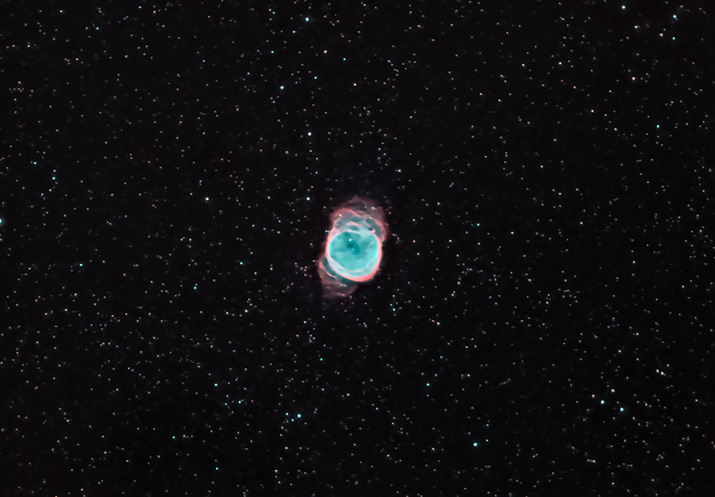
|
Date: Sept. 25, 2019 - Location: Cowtown Observatory, Fort Worth, TX Telescope: C14 - Camera: QSI 632ws - Filters: Astrodon Ha and OIII Exposure: Ha = 120 min. - OIII = 90 min. Image Credit: Data Acquisition - Ronald Diliulio / Processing: Donald Waid Click on the image to view at higher resolution. |

|
Located in the constellation of Aquila (the Eagle), NGC6781 is an excellent example of a star that didn't have enough mass to actually blow itself to bits during a supernova at the end of its lifecycle. After medium mass stars, such as our Sun, use up their supply of "fuel" they expand and expel the outer layers of their gaseous envelopes into spectacular shells surrounding an extremely hot core. The resulting celestial objects are called Planetary Nebulae. This name has nothing to do with actual planets. When early astronomers viewed these faint objects through their small telescopes, they thought they looked like "fuzzy" planets. In larger telescopes, they often appear as smoke rings surrounding a central star which is shrinking into a white dwarf with each "puff" of stellar atmosphere. The shrinking star radiates so much ultraviolet energy it ionizes the escaping gas envelope until it "lights up" in much the same way a colorful neon light glows. The spheres of expelled gas are propelled outword were they will dissipate into interstellar space. When combining a series of very long exposures, like the image above, one can see at least 4 different rings, or as astronomers say, "shock fronts". Each of these fronts appears less dense correlating with the increasing distance, and therefore time of ejection, from the central star. This provides a hint that this star has been expelling material for many thousands of years. Astronomers have determined that these shells usually dissipate within about 10,000 years, and subsequently, cannot be distinguished from the surrounding interstellar gas. There is speculation that some Planetary Nebulae, such as NGC 6781, may persist for considerably longer time periods. The image above was assembled from two narrowband filtered images. These consisted of Ha mapped to red and OIII mapped to green and blue. This bi-color image approximates the true colors of the nebula. 1https://www.eso.org/public/images/ngc6781-potw/ 2https://www.aanda.org/articles/aa/abs/2005/16/aa2010/aa2010.html |